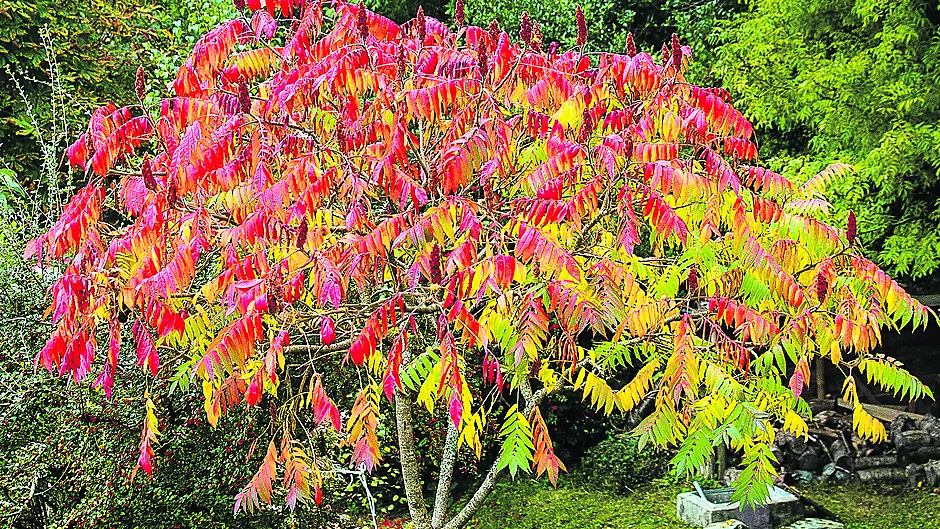THE September heatwave may be over but there is still plenty of warmth in each day. Plants will thrive and grow in the warm soil and, even when air temperatures dip, it takes a while for the land to cool down.
This means you can get some late sowings into the ground, or put some young plants in the soil and they will have the temperature that they like to establish themselves and to start growing well.
Fine weather makes all outdoor tasks more enjoyable. Take a look around the garden and start clearing and tidying what you can.
Lovely leaves
There has been plenty of sun to help sweeten the process of leaves turning colour on deciduous trees. The more sun there is, the more sugar the leaves make and the more sugar they contain, the brighter the colour that they turn in the autumn. A tree full of red, orange and gold leaves is a wonderful sight. Some trees produce better displays than others so if you love autumn colour, then try planting a sumac if you have a small garden. This small tree can give a spectacular autumn display – avoid planting in a shaded position or you may never see its colourful potential.
Maples are famous for their autumn colour. Choose carefully so you get a good mix of shades. I have several maples in my garden. One favourite is a large sugar maple that delights every year with its golden leaves. These stay on the tree later than the leaves on surrounding trees and the sugar maple remains a glowing golden beacon.
Deciduous trees do, of course, drop their leaves and stand bare for the winter. Make sure you are ready with rakes, blowers and barrows! Fallen leaves make a pretty mulch on empty beds or you can add a thin layer to the compost heap. You can also make a pile of leaves – contained in a wire mesh frame – and let it break down to make leafmould. This takes a couple of years so don’t be impatient.
Chilli peppers
There should be plenty of fruits on plants grown in a polytunnel, greenhouse or sunny window ledge and outdoor plants may have cropped well too. You can use the chillies while they are green, but they develop more heat and flavour as they ripen. Fruits will ripen on the plant as long as there is warmth and sun.
 Chilli peppers can dry in the sun. (Photo: Ben Russell)
Chilli peppers can dry in the sun. (Photo: Ben Russell)
I like to harvest a mix of green and ripe fruits – some go into bags in the freezer to be used in the same way as fresh chillies. Some are left to dry near a sunny window and they can go in a very low oven, for half an hour or so, just to finish the drying process.
Think about onions and garlic
If the ground is dry enough to dig then this is a good time to prepare beds for autumn planting varieties of onions and garlic. Both these plants like a moist soil but roots will rot if they are planted in a bed that gets too wet in the winter. Pile the soil up to make a raised ridge and add plenty of potash-rich feed such as powdered seaweed or wood ash. A layer of well-rotted manure can be added to the ridge and make sure there is soil on top of this. Onions and garlic like an alkaline soil so scatter a bit of lime on top if needed. Take care not to mix the lime and manure together – the chemical reaction will release nitrogen into the atmosphere. Walk up and down the bed, or whack it with the back of a shovel if you have strong arms, to compact the soil a little. Onions and garlic do best in a firm growing medium.
Planting may be delayed for another week or two, but it is good to have the beds ready and waiting.
Beetroot
Always lift beetroot before roots grow big and stringy. Small tender roots (technically a swollen stem but most people call them roots) are delicious. Small or medium roots take 30-40 mins to soften in boiling water, large roots take longer. Don’t peel or cut the flesh and don’t cut stems or roots too close before boiling. Damaged beetroot will bleed into the cooking water, losing nutrients and colour.
 Lift beetroot before plants bolt. (Photo: Ben Russell)
Lift beetroot before plants bolt. (Photo: Ben Russell)
Beetroot stores well. If you have grown lots, it is best to lift all roots and store in tubs of sand in a dry shed. Leave 3cm or so of stem and don’t damage roots before storing.
Time to sow
Autumn sowing varieties of pea such as Meteor, Douce Provence, or First Early May, can be sown outdoors. Use a cloche to protect small plants in cold weather. These varieties and mangetout Oregon Sugar Pod or Herald all do very well in a polytunnel or greenhouse.








